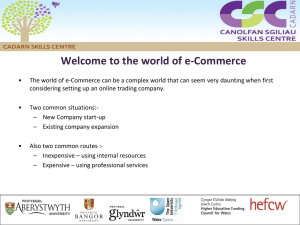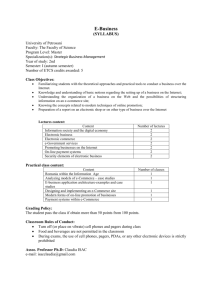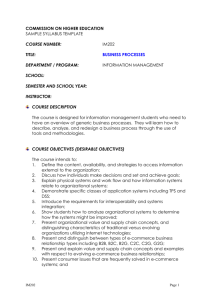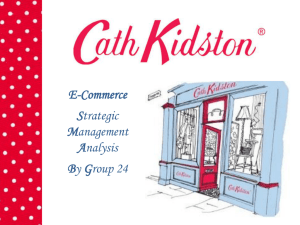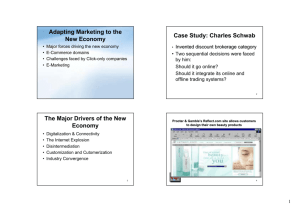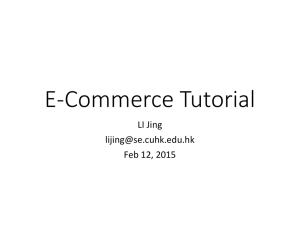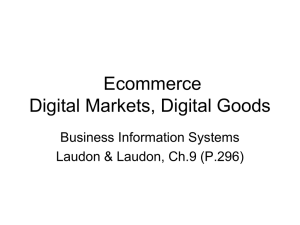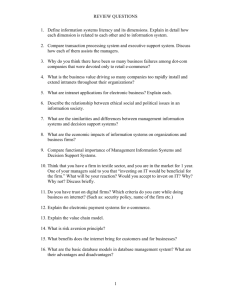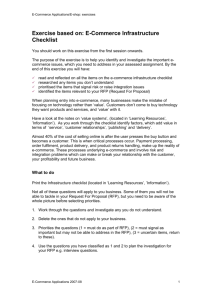1594_0_Patrick - Ecommerce education(FORMATED)
advertisement
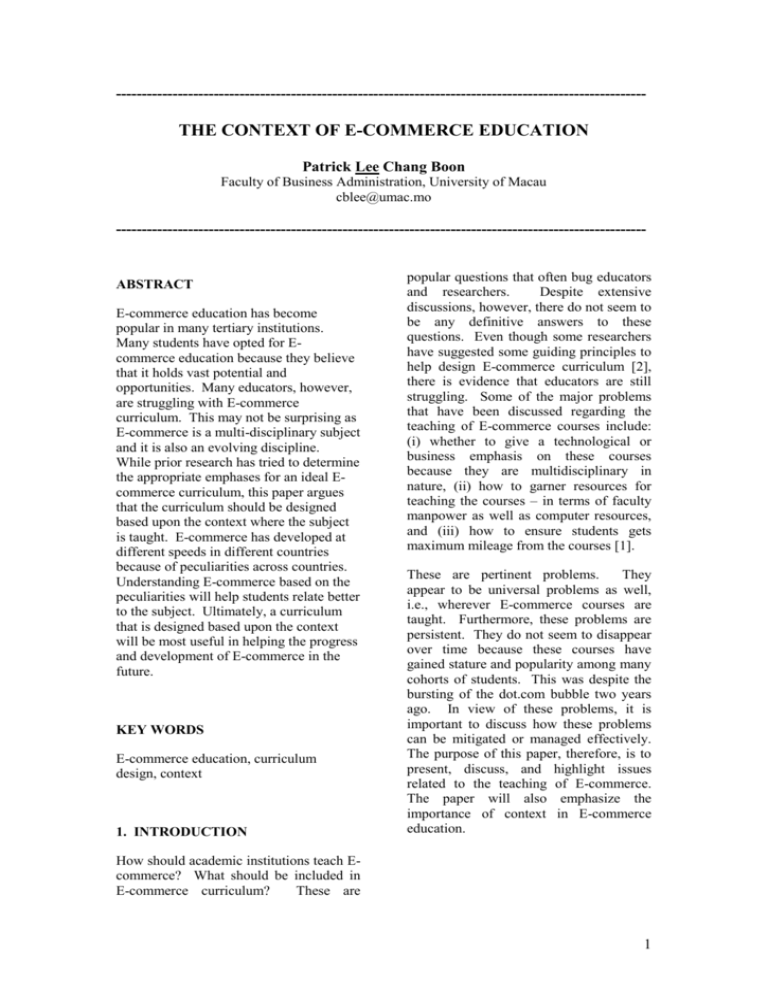
------------------------------------------------------------------------------------------------------- THE CONTEXT OF E-COMMERCE EDUCATION Patrick Lee Chang Boon Faculty of Business Administration, University of Macau cblee@umac.mo ------------------------------------------------------------------------------------------------------- ABSTRACT E-commerce education has become popular in many tertiary institutions. Many students have opted for Ecommerce education because they believe that it holds vast potential and opportunities. Many educators, however, are struggling with E-commerce curriculum. This may not be surprising as E-commerce is a multi-disciplinary subject and it is also an evolving discipline. While prior research has tried to determine the appropriate emphases for an ideal Ecommerce curriculum, this paper argues that the curriculum should be designed based upon the context where the subject is taught. E-commerce has developed at different speeds in different countries because of peculiarities across countries. Understanding E-commerce based on the peculiarities will help students relate better to the subject. Ultimately, a curriculum that is designed based upon the context will be most useful in helping the progress and development of E-commerce in the future. KEY WORDS E-commerce education, curriculum design, context 1. INTRODUCTION popular questions that often bug educators and researchers. Despite extensive discussions, however, there do not seem to be any definitive answers to these questions. Even though some researchers have suggested some guiding principles to help design E-commerce curriculum [2], there is evidence that educators are still struggling. Some of the major problems that have been discussed regarding the teaching of E-commerce courses include: (i) whether to give a technological or business emphasis on these courses because they are multidisciplinary in nature, (ii) how to garner resources for teaching the courses – in terms of faculty manpower as well as computer resources, and (iii) how to ensure students gets maximum mileage from the courses [1]. These are pertinent problems. They appear to be universal problems as well, i.e., wherever E-commerce courses are taught. Furthermore, these problems are persistent. They do not seem to disappear over time because these courses have gained stature and popularity among many cohorts of students. This was despite the bursting of the dot.com bubble two years ago. In view of these problems, it is important to discuss how these problems can be mitigated or managed effectively. The purpose of this paper, therefore, is to present, discuss, and highlight issues related to the teaching of E-commerce. The paper will also emphasize the importance of context in E-commerce education. How should academic institutions teach Ecommerce? What should be included in E-commerce curriculum? These are 1 2. E-COMMERCE AS A MULTIDISCIPLINARY SUBJECT E-commerce is a new and rapidly evolving form of commerce. Its growth is aided by breakthrough in information and communication technologies. These technologies allow data to be processed and transmitted in extremely high speed. Technologies, therefore, form an integral part of E-commerce. There are, however, other components in E-commerce as well. These include the business, legal, logistical and marketing components. Also, because E-commerce enables business to be conducted globally, an important aspect of E-commerce is that it involves doing business in many countries with different cultures. Thus, while technologies are the enablers of Ecommerce, E-commerce also encompasses a host of other subject areas. To design an E-commerce curriculum, therefore, one needs to include both the technology and non-technology aspects. There are two ways that institutions incorporate E-commerce subjects in their curriculum at the undergraduate level. Some offer it as a single, introductory, or foundation subject – as part of the curriculum for the business and accounting students. The objective of such a course is to provide students an insight into how future businesses may be conducted. Some institutions, however, choose to incorporate topics on Ecommerce as an extension of the parent subject. For example, a subject on principles of marketing would include topics on advertising in the internet, and a subject on commercial law would include topics on laws governing E-commerce transactions. This approach has the advantage of allowing topics on Ecommerce to be incorporated into the curriculum on an incremental basis. It allows parent-subject experts to leverage their expertise onto E-commerce. It is also less strenuous on staff requirements. The disadvantage, however, is that it is a piecemeal approach and it does not provide opportunities for students to view Ecommerce from a holistic perspective. At present, few institutions provide Ecommerce specialisation in their business curriculum at the undergraduate level. Many institutions subsume E-commerce specialisation under information systems or information technology. The majority of the universities in Hong Kong, for example, have business specialisation in information systems or information technology. A cursory examination of the course syllabus via the internet shows that E-commerce related subjects are usually offered as core or elective subjects for this specialisation. Without looking at the course details, it is difficult to comment or compare the topics covered in Ecommerce related subjects. As these subjects are offered in the business school, it is unlikely that these courses are technically oriented. Specialised E-commerce programmes are provided mostly at the graduate level. While E-commerce is multidisciplinary in nature and should rightfully cover both technical and non-technical aspects, it is possible that the range of subjects is very wide ranging. It is difficult to provide full coverage for the range of subjects within a limited time. It is logical, therefore, to design programmes that focus on specific areas. For example, the Chinese University of Hong Kong offers two Ecommerce related programmes. One is Masters of Science in E-Commerce Technologies and the other is Masters of Science in E-Business Management. The former is technically oriented while the latter is less technically oriented. 3. E-COMMERCE: AN EVOLVING DISCIPLINE As mentioned previously, E-commerce is a new and multi-disciplinary subject. It is difficult to find appropriate staff to teach the subject. If existing staff were utilized to teach the subject, they will have to be put on the learning curve. Because Ecommerce is continuously evolving, it means that the teaching curriculum will have to be updated frequently so that the contents remain current. The issue about 2 ensuring currency has implications for resource allocation because keeping pace with E-commerce development and designing an updated curriculum requires time and effort. It is unlike other courses where the contents are less dynamic. It is common for institutions to grant sabbatical leave for staff to prepare curriculum for new E-commerce subjects. Due to rapid development in the E-commerce industry, staff must be prepared to learn continuously. 4. E-COMMERCE AND TEACHING METHODS How can educators ensure that students derive maximum benefit from the course? What methods of teaching E-commerce will enhance experiences for the students? Many educators have different styles of teaching E-commerce courses. Some are contend to use the traditional lectures and tutorials method. Dhamija, Heller and Hoffman (1999) [3] have used unique teaching arrangements and styles – for example, bringing together students with different backgrounds at different levels to engage in real-world e-commerce projects. The projects provide students with insights into the functioning of an E-commerce environment. The students also get to listen to professional speakers talk about their E-commerce experiences. The resources put into designing and implementing this course were undoubtedly high. The example, however, provides a pedagogical benchmark for courses seeking similar objectives. Since E-commerce is a practical subject, some kind of hands-on experience will be useful. A course that is based solely on route learning would not get students excited. At the elementary level, I suggest that students taking E-commerce specialisation should be able to host a web-site for personal or business purpose. This will be a good learning experience because students can see for themselves the product of their work. Apart from reading textbooks and doing projects, I would also argue that incorporating local case studies might help students to appreciate E-commerce better. Local settings enable students to relate better, and hopefully they can apply concepts they have learned to something they are familiar with. 5. E-COMMERCE TEACHING: A STANDARD CURRICULUM? E-commerce holds vast potential. Forrester Research estimates that North America would realize USD 3.5 trillion of E-commerce transactions in 2004. This would make it the leading country in Ecommerce trade (http://www.epaynews .com/statistics/transactions.html). Ecommerce is slowly catching on in many countries. It is gaining acceptance among many organizations and consumers. Because many countries are anxious to jump into the E-commerce bandwagon, many educational institutions have created E-commerce courses that are modeled on courses offered in the West, where Ecommerce has reached a sophisticated standing. I argue, however, that the curriculum for E-commerce education should be tailored based on the circumstances existing in the country. If a country is poor in information communications infrastructure, then the primary mission should be to set up the infrastructure and produce citizens who are computer literate. It would be irrelevant to teach Ecommerce in such a context. If a country has got good information communications infrastructure, then the next question to ask is why is E-commerce not working? Many countries have tried to implement Ecommerce like what has been done in the West, and have found that the implementation did not always work. The pertinent question to ask is why didn’t Ecommerce take off in these countries? It may be difficult to answer this question because peculiarities exist in every country. For example, barriers to Ecommerce in some countries may be due 3 to government regulations, legal constraints, inadequate technologies, or the way business is conducted [4]. It will be more appropriate if E-commerce were taught in the context based on the circumstances of the country where the subject is taught. If lack of E-commerce laws were hindering development of Ecommerce in the country, then there should be more emphasis on E-commerce laws in the E-commerce curriculum. In this way, the teaching of E-commerce can results in two practical end products – (1) students become more knowledgeable in the subject area within the local context, and (2) students may be more knowledgeable and responsive to overcome E-commerce barriers when they graduate from their course. Ultimately, such a curriculum will enhance Ecommerce development in the country. Thus, the maxim is to pitch E-commerce courses according to context. Overall, therefore, it may not be sufficient to cover topics in a standard E-commerce textbook. E-commerce curriculum should include contents that reflect the context of the countries where E-commerce is being taught. Students should not only learn about the idealized state of an Ecommerce environment, but they should also learn about how they can overcome barriers to E-commerce in their country. 6. CONCLUSION While prior research has discussed many issues regarding E-commerce education, it has rarely discussed the importance of contextualizing curriculum according to developments within the country. Contextualising is important, particularly in the case for E-commerce education, because it can help students to relate and understand the subject better. Furthermore, contextualising can improve E-commerce development by helping to identify and overcome barriers that exist within organizations and countries. Ultimately, a contextualised E-commerce curriculum may provide more benefits compared to a standardised curriculum. REFERENCES [1] Chan, S., Challenges and opportunities in E-commerce education, Proceedings of the Seventh Americas Conference in Information Systems, 2002. [2] Dean, D.L. and Nasirin, S, Principles of effective E-commerce curriculum development, Communications of the Association for Information Systems, 9, 2002, 378-391. [3] Dhamija, R. Heller, R. and Hoffman, L.J., Teaching E-commerce to a multidisciplinary class, Communications of the ACM, 42(9), 1999, 50-55. [4] Martinsons, M.G., Electronic commerce in China: emerging success stories, Information & Management, 39(7), 2002, 571-579. [5] Zhang, Q. B. and Chua, P.Y.K. Creating E-commerce courses with regional intent, Communications of the ACM, 44(2), 2002, 35-37. [6] Rob, M. The rise and fall of an Ecommerce programme, Communications of the ACM, 46(3), 2002, 25-26. 4
